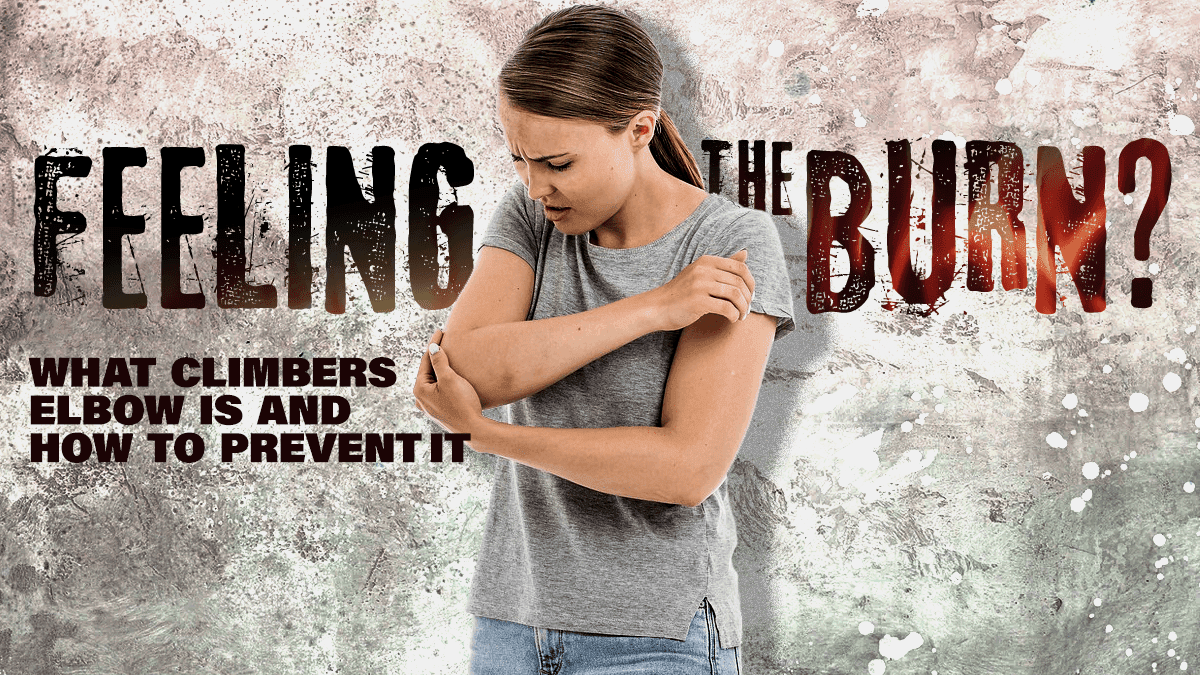Feeling the Burn? What Climbers Elbow is and How to Prevent It

There’s nothing worse than wanting to do something but not being able to (for one reason or another).
As climbers, we face this dilemma when we become injured — like developing tendonitis. Tendonitis is the inflammation of the tissue that connects muscles to bones.
It’s typically an injury caused by overuse. When it happens in the elbow, it can either be medial (called golfer’s elbow) or lateral (called tennis elbow).
We’re hoping you’re reading this out of curiosity and prevention rather than treatment, but either way, you’ve come to the right place.
Keep reading to find out more about climbers elbow, how to prevent it, and options for treatment if you’re experiencing it.

What Is Climbers Elbow And Why Does It Happen?
We opened up this article by talking about golfer’s and tennis elbow, but what about climber’s elbow?
The answer is that it’s the same as golfer’s elbow. The muscles in your arm (and body, for that matter) connect to one another, meaning stress on one leads to stress on others.
When climbing, your finger and wrist movements (and holds) cause your muscles to contract. They contract all the way up to your arm, putting a strain on the tendons that connect your forearm muscles to your bony elbow.
It mainly happens if there’s too much strain for too long without rest, as in weeks and weeks (possibly longer) of overactivity. The tendon becomes aggravated and inflamed.
This causes pain on the bony part of your inner elbow, called the medial epicondyle. An epicondyle is a protuberance on your bone, so the medial epicondyle is the protuberance on the inside of your arm.
Golfer’s (or climber’s) elbow is technically called medial epicondylitis. The symptoms of this condition include:
- Elbow stiffness
- Difficulty moving without pain
- Localized pain along the inside of the forearm, at the bony protrusion
- Radiating pain into forearm, wrists, or fingers
- Tingling or numbness in the fingers
Unfortunately, this overuse injury can become so painful that you can’t climb and other activities of daily living become painful.
Here are some ideas of what you can do to begin treatment if you’re experiencing climber’s elbow.
How To Treat Climbers Elbow
We must disclaim that we aren’t medical professionals and that these are merely suggestions. We cannot suggest the timeframe of these methods, but it’s at least a place for you to start.
Climber’s elbow will go away on its own if you rest. If you want to speed up recovery, consider the following.
- Rest
- Treat pain and inflammation with ice and NSAIDs (anti-inflammatories, like ibuprofen)
- Slowly regain mobility through gentle stretching
- Resistance strength training
- Movement training once the pain has subsided significantly
The main point in all of this is to highlight that rest is a requirement. Other treatment methods aren’t guaranteed and if you aren’t resting, won’t work anyhow.
If your pain doesn’t subside in a reasonable amount of time or if it becomes severe, see a doctor.
How To Prevent Climbers Elbow
We’ll say it again out of importance (and because we know how addicting it is to keep climbing): take rest days.
If you feel any pain coming on, don’t push through it. Give yourself extra rest to heal and let your muscles and tendons relax.
Aside from rest, you should regularly stretch. In an earlier article, we talked about how failing to stretch is one of the most common training mistakes.
If you’re stretching before climbing, do so lightly because your muscles haven’t warmed up yet. You can injure yourself if you try to stretch too deep when they’re cold.
You should also stretch within 30 minutes after a climb. Consider the gorilla pose, the tabletop wrist flexion stretch, and other wrist and forearm stretches.
Additionally, make sure to incorporate strength training into your routine. Healthline suggests that building arm strength by lifting weights or squeezing a tennis ball may help prevent climber’s elbow.
Climb Safely
If you don’t take care of yourself, you won’t be able to climb at all.
This includes climbing safely with the right shoes and gear.
Follow our advice to prevent climber’s elbow (hint: rest and stretch). While you’re doing those things, keep reading our blog for more climbing news and information.




